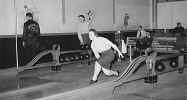
Dull Jack and Jill
july 31, 2000. You can see it from blocks away —
the marquee of the Coronet Theater, mauve against the
pale blue sky. For more than 50 years, the
self-proclaimed "crown jewel of the Bay Area
entertainment sphere" has adorned the top of the
hill on Geary Boulevard. But now, the newspapers tell
us, the old jewel has lost her luster. She is to be
plucked from her setting and replaced by the Goldman
Institute on Aging.
Preservationists and powers-that-be
are upset about her impending demise. Supervisor Gavin
Newsom has called a special meeting of the Small
Business, Economic Vitality and Consumer Services
Committee for August 4, in an attempt to prevent the few
remaining single-screen theaters from sharing her fate.
The League of Historic American Theaters, meeting in San
Francisco this week, will tour her premises.
Indeed, the Coronet deserves a moment
of our attention. Built in 1949 as the "lucky
seventh" in Samuel H. Levin’s San Francisco
Theaters group, the theater originally accommodated
2,100 movie-goers in style: viewers enjoyed "more
leg room plus larger seats," reported the Examiner,
with a choice of "Venetian red plush-backed"
loges or "opalescent green rocking chair type"
seats. The auditorium boasted gold murals in Arthurian
motifs and three layers of curtains in gold, silver, and
burgundy. Elsewhere, concern for customers’ comfort
created a 400-car parking lot and "a women’s
powder room said to rank with I. Magnin’s and Seals
Stadium for artistic décor."
The first movie in November 1949 was
"I Was a Male War Bride," which had opened at
the Fox two weeks before. San Francisco movie maven Jack
Tillmany observes that "in the beginning, [the
Coronet’s] place in the order of things was sort of an
upgraded Coliseum, not the prestige house it later would
become." The change came quickly. On December 26,
1956, notes Tillmany, "‘Around the World in 80
Days’ opened at the Coronet and played a total of 94
weeks, closing on October 19, 1958, during which time it
played in no other theater in the San Francisco Bay
Area; this still stands as the longevity record for any
single film in any single theater" in the city. The
Chronicle’s Peter Stack adds that George Lucas
"includes the Coronet on his personal list of
places to see films."
In other words, this jewel on the hill
has served us long and well, and deserves our gratitude.
Some of the outcry over its demolition resembles a
campaign to turn an old workhorse out to pasture instead
of dooming it to the glue factory. Some expresses a
simple sorrow over the destruction of a once-beautiful
building. But some mourns the loss of a meaningful
element in people’s lives, and here the
preservationists may be barking up the wrong tree. Or
marquee.
Listen to people’s reminiscences
about movie-going. For many decades in San Francisco —
and the rest of the United States — the movie palace
took center stage in community life. Inexpensive and
local, it offered a safe place for children to amuse
themselves. Part of the childhood experience was the
kiddie matinee. Older kids used it as a place to
socialize and be socialized. Families out on the town
went to the movies as a matter of course. So did adults.

It’s easy to blame the decline of
movie attendance on the advent of television, the
monopolistic film distribution system, or the rise of
multiplexes. But the same thing has happened to bowling
alleys and skating rinks, which once served a similar
function in American family life. The Japantown Bowl is
only the latest casualty. They’re all disappearing.
The San Francisco phone book for 1949,
the year the Coronet opened, lists eight skating rinks,
including Winterland at Post and Steiner, "home of
the San Francisco Shamrocks, with hockey Wednesday and
Saturday nights"; today one rink in the city is
listed. In 1949 there were thirteen bowling alleys in
San Francisco; today most of the listings are for
facilities in Daly City. Thirty billiard parlors have
given way to ten.
What’s going on? The
"theater" listings offer a clue. In 1949 the
phone company lumped about 100 stage and screen
facilities together, with the movie theaters
predominating. Today movie listings, including porno
theaters, number about 30, while the number of
legitimate theaters has mushroomed. The message:
entertainment is for adults.
Just as the construction of live/work
lofts sends a signal of "No Children Wanted,"
so the organization of public leisure space says,
"Families Not Welcome." Particularly families
with little disposable income. How shortsighted to plan
for a city with no future! How suicidal! How boring.
■